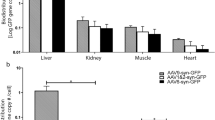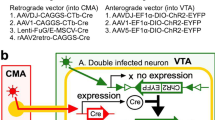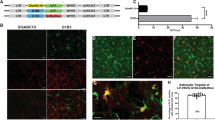Abstract
Gene transfer to the early-stage embryonic brain using the ultrasound image-guided gene delivery (UIGD) technique has proven to be valuable for investigating brain development. Thus far, this technology has been restricted to the study of embryonic neurogenesis. When this technique is designed to be employed for the study in adult animals, a long-term stable gene expression will be required. We attempted to develop a retroviral vector suitable for expressing exogenous genes in the brains of postnatal and adult mice in the context of the UIGD technique. Retroviral vectors containing four different long terminal repeats (LTRs) (each from Moloney murine leukemia virus (MoMLV), murine stem cell virus (MSCV), myeloproliferative sarcoma virus (MPSV) and spleen focus-forming virus (SFFV)) were compared using the well-known CE vector having the EF1α internal promoter as a control. The MS vector containing MSCV LTR produced a higher viral titer and a higher level of gene expression than other vectors including CE. The MS vector drove the gene expression in cultured neural stem cells for 3 weeks. Furthermore, the MS vector could efficiently deliver the gene to the mouse central nervous system, as transgene expression was found in various regions of the brains and spinal cords as well as in all major neural cell types. The data from an in vivo luciferase imaging analysis showed that the gene expression from the MS vector was sustainable for almost 3 months. Our data suggested that the MS vector would be suitable to construct mice containing the transgene expressed in the brain or spinal cord in a quick and cost-effective manner.
This is a preview of subscription content, access via your institution
Access options
Subscribe to this journal
Receive 12 print issues and online access
$259.00 per year
only $21.58 per issue
Buy this article
- Purchase on Springer Link
- Instant access to full article PDF
Prices may be subject to local taxes which are calculated during checkout









Similar content being viewed by others
References
Liu A, Joyner AL, Turnbull DH . Alteration of limb and brain patterning in early mouse embryos by ultrasound-guided injection of Shh-expressing cells. Mech Dev 1998; 75: 107–115.
Gaiano N, Kohtz J, Turnbull D, Fishell G . A method for rapid gain-of-function studies in the mouse embryonic nervous system. Nat Neurosci 1999; 2: 812–819.
Gaiano N, Nye JS, Fishell G . Radial glial identity is promoted by Notch1 signaling in the murine forebrain. Neuron 2000; 26: 395–404.
Yoon K, Nery S, Rutlin ML, Radtke F, Fishell G, Gaiano N . Fibroblast growth factor receptor signaling promotes radial glial identity and interacts with Notch1 signaling in telencephalic progenitors. J Neurosci 2004; 24: 9497–9506.
Kim S, Lee K, Kim M, Kang S, Joo C, Kim J et al. Factors affecting the performance of different long terminal repeats in the retroviral vector. Biochem Biophys Res Commun 2006; 343: 1017–1022.
Hong Y, Yu SS, Kim JM, Lee K, Na YS, Whitley CB et al. Construction of a high efficiency retroviral vector for gene therapy of Hunter's syndrome. J Gene Med 2003; 5: 18–29.
Soneoka Y, Cannon PM, Ramsdale EE, Griffiths JC, Romano G, Kingsman SM et al. A transient three-plasmid expression system for the production of high titer retroviral vectors. Nucleic Acids Res 1995; 23: 628–633.
Naumann N, De Ravin S, Choi U, Moayeri M, Whiting-Theobald N, Linton G et al. Simian immunodeficiency virus lentivector corrects human X-linked chronic granulomatous disease in the NOD/SCID mouse xenograft. Gene Therapy 2007; 14: 1513–1524.
Baum C, Hegewisch-Becker S, Eckert HG, Stocking C, Ostertag W . Novel retroviral vectors for efficient expression of the multidrug resistance (mdr-1) gene in early hematopoietic cells. J Virol 1995; 69: 7541–7547.
Engels B, Cam H, Schuler T, Indraccolo S, Gladow M, Baum C et al. Retroviral vectors for high-level transgene expression in T lymphocytes. Hum Gene Ther 2003; 14: 1155–1168.
Jahner D, Stuhlmann H, Stewart CL, Harbers K, Lohler J, Simon I et al. De novo methylation and expression of retroviral genomes during mouse embryogenesis. Nature 1982; 298: 623–628.
Challita PM, Kohn DB . Lack of expression from a retroviral vector after transduction of murine hematopoietic stem cells is associated with methylation in vivo. Proc Natl Acad Sci USA 1994; 91: 2567–2571.
Klug CA, Cheshier S, Weissman IL . Inactivation of a GFP retrovirus occurs at multiple levels in long-term repopulating stem cells and their differentiated progeny. Blood 2000; 96: 894–901.
Stewart CL, Stuhlmann H, Jahner D, Jaenisch R . De novo methylation, expression, and infectivity of retroviral genomes introduced into embryonal carcinoma cells. Proc Natl Acad Sci USA 1982; 79: 4098–4102.
Lipshutz G, Gruber C, Cao Y, Hardy J, Contag C, Gaensler K . In utero delivery of adeno-associated viral vectors: intraperitoneal gene transfer produces long-term expression. Mol Ther 2001; 3: 284–292.
Pannell D, Osborne CS, Yao S, Sukonnik T, Pasceri P, Karaiskakis A et al. Retrovirus vector silencing is de novo methylase independent and marked by a repressive histone code. EMBO J 2000; 19: 5884–5894.
Gautsch JW, Wilson MC . Delayed de novo methylation in teratocarcinoma suggests additional tissue-specific mechanisms for controlling gene expression. Nature 1983; 301: 32–37.
Niwa O, Yokota Y, Ishida H, Sugahara T . Independent mechanisms involved in suppression of the Moloney leukemia virus genome during differentiation of murine teratocarcinoma cells. Cell 1983; 32: 1105–1113.
Kempler G, Freitag B, Berwin B, Nanassy O, Barklis E . Characterization of the Moloney murine leukemia virus stem cell-specific repressor binding site. Virology 1993; 193: 690–699.
Yao S, Sukonnik T, Kean T, Bharadwaj RR, Pasceri P, Ellis J . Retrovirus silencing, variegation, extinction, and memory are controlled by a dynamic interplay of multiple epigenetic modifications. Mol Ther 2004; 10: 27–36.
Yu S, Han E, Hong Y, Lee J, Kim S . Construction of a retroviral vector production system with the minimum possibility of a homologous recombination. Gene Therapy 2003; 10: 706–711.
Acknowledgements
This work was supported by the grant given to S Kim's university laboratory by Brain Research Center of the 21st Century Frontier Research Program funded by the Ministry of Education, Science and Technology (#2011K000287), in which ViroMed Co. Ltd is a participating company.
Author information
Authors and Affiliations
Corresponding author
Ethics declarations
Competing interests
The authors declare no conflict of interest.
Rights and permissions
About this article
Cite this article
Jang, J., Yoon, K., Hwang, D. et al. A retroviral vector suitable for ultrasound image-guided gene delivery to mouse brain. Gene Ther 19, 396–403 (2012). https://doi.org/10.1038/gt.2011.120
Received:
Revised:
Accepted:
Published:
Issue Date:
DOI: https://doi.org/10.1038/gt.2011.120
Keywords
This article is cited by
-
Regulation of CCAAT/enhancer-binding protein (C/EBP) α in human-cytomegalovirus-infected fibroblasts
Archives of Virology (2016)



